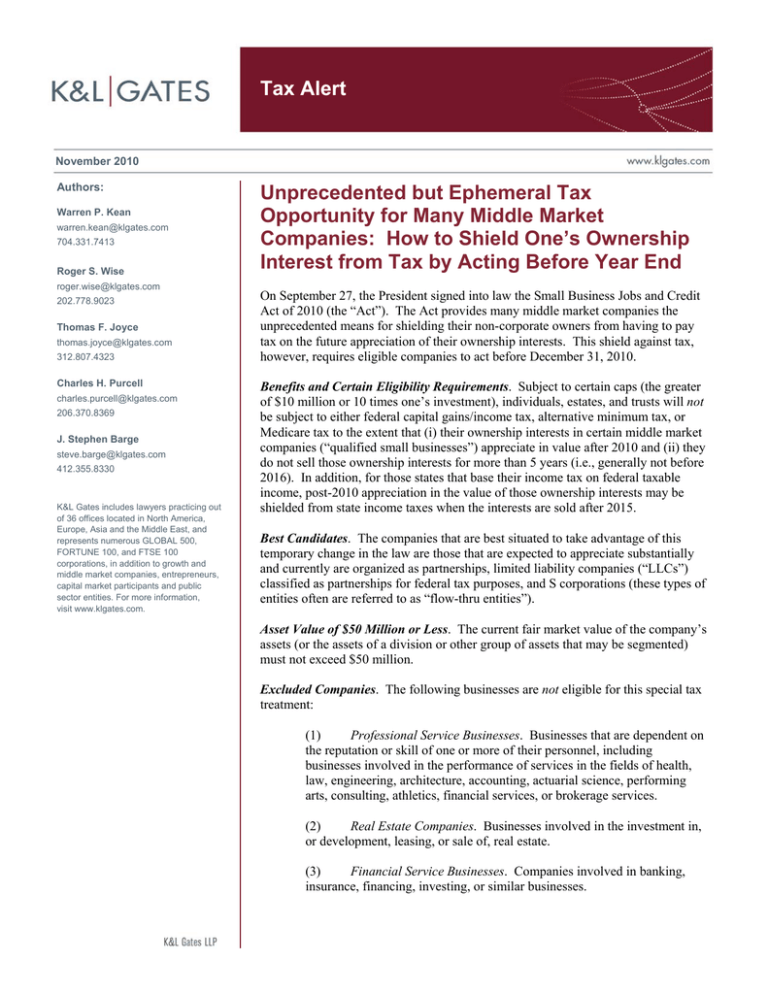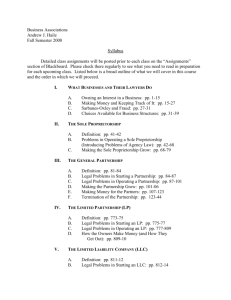
Tax Alert
November 2010
Authors:
Warren P. Kean
warren.kean@klgates.com
704.331.7413
Roger S. Wise
roger.wise@klgates.com
202.778.9023
Thomas F. Joyce
thomas.joyce@klgates.com
312.807.4323
Charles H. Purcell
charles.purcell@klgates.com
206.370.8369
J. Stephen Barge
steve.barge@klgates.com
412.355.8330
K&L Gates includes lawyers practicing out
of 36 offices located in North America,
Europe, Asia and the Middle East, and
represents numerous GLOBAL 500,
FORTUNE 100, and FTSE 100
corporations, in addition to growth and
middle market companies, entrepreneurs,
capital market participants and public
sector entities. For more information,
visit www.klgates.com.
Unprecedented but Ephemeral Tax
Opportunity for Many Middle Market
Companies: How to Shield One’s Ownership
Interest from Tax by Acting Before Year End
On September 27, the President signed into law the Small Business Jobs and Credit
Act of 2010 (the “Act”). The Act provides many middle market companies the
unprecedented means for shielding their non-corporate owners from having to pay
tax on the future appreciation of their ownership interests. This shield against tax,
however, requires eligible companies to act before December 31, 2010.
Benefits and Certain Eligibility Requirements. Subject to certain caps (the greater
of $10 million or 10 times one’s investment), individuals, estates, and trusts will not
be subject to either federal capital gains/income tax, alternative minimum tax, or
Medicare tax to the extent that (i) their ownership interests in certain middle market
companies (“qualified small businesses”) appreciate in value after 2010 and (ii) they
do not sell those ownership interests for more than 5 years (i.e., generally not before
2016). In addition, for those states that base their income tax on federal taxable
income, post-2010 appreciation in the value of those ownership interests may be
shielded from state income taxes when the interests are sold after 2015.
Best Candidates. The companies that are best situated to take advantage of this
temporary change in the law are those that are expected to appreciate substantially
and currently are organized as partnerships, limited liability companies (“LLCs”)
classified as partnerships for federal tax purposes, and S corporations (these types of
entities often are referred to as “flow-thru entities”).
Asset Value of $50 Million or Less. The current fair market value of the company’s
assets (or the assets of a division or other group of assets that may be segmented)
must not exceed $50 million.
Excluded Companies. The following businesses are not eligible for this special tax
treatment:
(1)
Professional Service Businesses. Businesses that are dependent on
the reputation or skill of one or more of their personnel, including
businesses involved in the performance of services in the fields of health,
law, engineering, architecture, accounting, actuarial science, performing
arts, consulting, athletics, financial services, or brokerage services.
(2)
Real Estate Companies. Businesses involved in the investment in,
or development, leasing, or sale of, real estate.
(3)
Financial Service Businesses. Companies involved in banking,
insurance, financing, investing, or similar businesses.
Tax Alert
(4)
Leasing Companies. Leasing businesses.
(5)
Hospitality Companies. Hotels, motels,
restaurants, and similar businesses.
(6)
Farms and Mining and Other Mineral
Extraction Companies. Companies involved in the
business of farming or the extraction of minerals.
A company will be considered to be conducting an
ineligible business if more than 20% of its assets (by
value) pertain to any of the above enterprises or to
investment or other passive activities.
Required Action. To take advantage of this
opportunity, (i) a qualified business will need to be
organized or reorganized as a taxable “C”
corporation or an entity that will be classified as a
“C” corporation for federal tax purposes, and (ii)
that organization or reorganization as a C
corporation must occur before January 1, 2011. In
the case of a partnership or LLC, this reorganization
may be accomplished fairly easily by filing a form
with the IRS and making appropriate amendments to
the company’s partnership or operating agreement.
Built-in Gain Does Not Qualify for Exclusion.
The exclusion from tax on the sale of small business
stock (or ownership interests that are treated as stock
for federal tax purposes) does not apply to the
owner’s built-in gain at the time a flow-thru entity is
converted (or deemed for tax purposes to be
converted) into a C corporation. For example,
assume the adjusted tax basis of a member’s
membership interest in an LLC (characterized as a
flow-thru entity for federal tax purposes) is $1
million (as is the member’s share of the LLC’s
adjusted bases in its assets) and the fair market value
of the member’s interest in the LLC’s assets is $3
million on the day that the LLC files the election
form with the IRS to be classified as a C corporation
for federal tax purposes (or other effective date of
that filing). In 2016, the member sells the
membership interest for $10 million. Under those
facts, the $7 million post-election appreciation will
not be taxed. The $2 million built-in gain ($3
million - $1 million), however, will be subject to
federal capital gains tax (and presumably state
income tax) as well as the 3.8% Medicare tax on net
investment income that takes effect on January 1,
2013.
Five-Year Holding Period. Only gain on the sale of
shares of qualified small business stock (or
ownership interests treated as stock for federal tax
purposes) that have been held for more than 5 years
by those who acquired the shares from the
corporation (and not from other shareholders)
qualifies for the exclusion from tax when that stock
is sold. Thus, sales of all or a portion of one’s
qualified small business stock during the next 5
years (i.e., generally before 2016) will be subject to
the same tax treatment as the sale of stock issued by
any other C corporation.
Certain Consequences of Reorganizing a FlowThru Entity as a C Corporation. Changing the
manner in which the company is taxed from a flowthru entity to a C corporation represents a major
shift in the tax structure of a business and will have
the following consequences:
(1)
Entity-Level Tax. The earnings
and capital gains of the business will be
taxed at corporate rates (a maximum
federal rate of 34% on net income and gain
of $10 million or less and 35% on net
income and gain over $10 million) instead
of those earnings and capital gains flowing
through to the owners and taxed, for
individuals, at a maximum federal ordinary
income tax rate of 39.6% and a maximum
federal long-term capital gains tax rate of
20% (assuming that Congress fails to
extend the current tax rates or enact some
other rates) plus the new 3.8% Medicare
tax on those capital gains.
(2)
Double Taxation on Distributed
Earnings. Earnings of the company that
are distributed to its owners as dividends
will be subject to a second federal and state
income tax. The maximum federal income
tax rate on dividends received by
individuals is scheduled to increase from
15% to 39.6% on January 1, 2011. Also,
dividends are included in the type of net
investment income that will be subject to a
3.8% Medicare tax beginning in 2013.
(3)
Character and Timing of Losses.
Any losses of the business will no longer
flow through to the owners. This can delay
November 2010
2
Tax Alert
the time in which those losses may be used
to offset other income and change the
character of those losses from ordinary
losses (that can offset ordinary income that
would otherwise be subject to a maximum
federal income tax rate for individuals of
39.6%) to capital losses (that generally may
be used only to offset capital gains). There,
however, is a special provision in the
federal tax law that allows married
individuals filing joint returns to deduct as
an ordinary loss up to $100,000 ($50,000
for non-married individuals or married
individuals filing separate returns) of losses
per year from the sale of shares of certain
small business stock in C corporations (or
entities that elect to be treated as C
corporations for federal tax purposes) that
have a net worth of $1,000,000 or less on
the date that the stock was issued.
(4)
Simplification of Tax Reporting.
By converting from a flow-thru entity to a C
corporation (or an entity that elects to be
classified as a C corporation), the company
will no longer be required to deliver
Schedule K-1s to its owners to enable them
to complete and file their federal and state
income tax returns. Also, an owner will no
longer be required to prepare and file (on a
composite or individual basis) income tax
returns and pay taxes in those states and
other jurisdictions in which the company,
but not the owner, owns property or
conducts business.
(5)
Loss of Tax Flexibility. Converting
a flow-thru entity to an entity that is taxed
as a C corporation usually is relatively easy
and painless. A C corporation, however,
usually cannot convert to a flow-thru entity
(other than an S corporation) without
triggering corporate and shareholder tax on
the built-in gain of the company’s assets.
Thus, once the company is converted to a C
corporation, the owners likely will be stuck
with that decision (particularly with respect
to not being able to convert back to
partnership tax status without having to pay
two levels of tax on the company’s built-in
gains).
(6)
Sale of C Corporations Usually
Structured as Stock Sales. Because of the
two levels of tax that are imposed on the
sale of assets by a C corporation and the
distribution of sale proceeds to its owners,
most sales of businesses classified as C
corporations for federal income tax
purposes are accomplished by the actual or
deemed sale of the company’s outstanding
stock. Stock sales often (but not always)
are viewed (and, thereby, priced) less
favorably by prospective buyers of
companies than asset sales or transactions
that can be treated as asset sales for federal
income tax purposes.
Conclusion. The ability to act before the end of
2010 to position certain qualifying middle market
companies to allow their owners to sell their
ownership interests in the company without having
to pay any income, capital gains, alternative
minimum, or Medicare tax on the post-2010
appreciation in the value of those interests is an
extraordinary and unprecedented opportunity that
many of these companies will want to explore with
tax counsel and other tax advisors. Any S
corporation, partnership, and LLC with assets that
have a combined gross fair market value of $50
million or less (or has one or more divisions or other
groups of assets that meet this valuation threshold
and may be readily transferred to a new, affiliated
entity) should evaluate this opportunity.
Circular 230 Notice: To ensure compliance with requirements imposed by the IRS, we inform you that any U.S. federal tax advice contained
in this communication (including any attachments) is not intended or written to be used, and cannot be used, for the purpose of (i) avoiding
penalties under the Internal Revenue Code of 1986, as amended or (ii) promoting, marketing or recommending to another party any transaction
or matter addressed within.
November 2010
3
Tax Alert
Anchorage Austin Beijing Berlin Boston Charlotte Chicago Dallas Dubai Fort Worth Frankfurt Harrisburg Hong Kong London
Los Angeles Miami Moscow Newark New York Orange County Palo Alto Paris Pittsburgh Portland Raleigh Research Triangle Park
San Diego San Francisco Seattle Shanghai Singapore Spokane/Coeur d’Alene Taipei Tokyo Warsaw
Washington, D.C.
K&L Gates includes lawyers practicing out of 36 offices located in North America, Europe, Asia and the Middle East, and represents numerous
GLOBAL 500, FORTUNE 100, and FTSE 100 corporations, in addition to growth and middle market companies, entrepreneurs, capital market
participants and public sector entities. For more information, visit www.klgates.com.
K&L Gates comprises multiple affiliated entities: a limited liability partnership with the full name K&L Gates LLP qualified in Delaware and
maintaining offices throughout the United States, in Berlin and Frankfurt, Germany, in Beijing (K&L Gates LLP Beijing Representative Office), in
Dubai, U.A.E., in Shanghai (K&L Gates LLP Shanghai Representative Office), in Tokyo, and in Singapore; a limited liability partnership (also named
K&L Gates LLP) incorporated in England and maintaining offices in London and Paris; a Taiwan general partnership (K&L Gates) maintaining an
office in Taipei; a Hong Kong general partnership (K&L Gates, Solicitors) maintaining an office in Hong Kong; a Polish limited partnership (K&L
Gates Jamka sp.k.) maintaining an office in Warsaw; and a Delaware limited liability company (K&L Gates Holdings, LLC) maintaining an office in
Moscow. K&L Gates maintains appropriate registrations in the jurisdictions in which its offices are located. A list of the partners or members in each
entity is available for inspection at any K&L Gates office.
This publication is for informational purposes and does not contain or convey legal advice. The information herein should not be used or relied upon
in regard to any particular facts or circumstances without first consulting a lawyer.
©2010 K&L Gates LLP. All Rights Reserved.
November 2010
4



